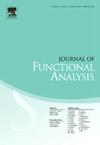A new characterization of the dissipation structure and the relaxation limit for the compressible Euler-Maxwell system
IF 1.7
2区 数学
Q1 MATHEMATICS
引用次数: 0
Abstract
We investigate the three-dimensional compressible Euler-Maxwell system, a model for simulating the transport of electrons interacting with propagating electromagnetic waves in semiconductor devices. First, we establish the global well-posedness of classical solutions near constant equilibrium in a critical regularity setting, uniformly with respect to the relaxation parameter . Then, we introduce an effective unknown motivated by Darcy's law to derive quantitative error estimates at the rate between the rescaled Euler-Maxwell system and the limiting drift-diffusion model. This provides the first global-in-time strong convergence result for the relaxation procedure in the case of ill-prepared data so far.
We propose a new characterization of the dissipation structure for the non-symmetric relaxation of linearized Euler-Maxwell system, which partitions the frequency space into three distinct regimes (low, medium and high frequencies) associated with different behaviors of the solution. Within each regime, the application of Lyapunov functionals based on the hypocoercivity theory reveals the expected dissipative properties. Moreover, two correction functions are employed to take care of the initial layers in the relaxation convergence.
可压缩欧拉-麦克斯韦系统耗散结构和松弛极限的新表征
我们研究了三维可压缩欧拉-麦克斯韦系统,这是一个模拟半导体器件中与传播电磁波相互作用的电子输运的模型。首先,我们以松弛参数ε>;0为中心,在临界正则条件下,建立了经典解在常平衡附近的全局适定性。然后,我们引入了一个由达西定律驱动的有效未知数,以0 (ε)的速率导出了重标欧拉-麦克斯韦系统与极限漂移扩散模型之间的定量误差估计。这提供了迄今为止在准备不足的数据情况下松弛过程的第一个全局实时强收敛结果。我们提出了线性化Euler-Maxwell系统非对称弛豫的耗散结构的新表征,该表征将频率空间划分为与解的不同行为相关的三个不同的区域(低、中、高频)。在每个区域内,基于低矫顽力理论的Lyapunov泛函的应用揭示了预期的耗散性质。此外,采用两个校正函数对松弛收敛中的初始层进行校正。
本文章由计算机程序翻译,如有差异,请以英文原文为准。
求助全文
约1分钟内获得全文
求助全文
来源期刊
CiteScore
3.20
自引率
5.90%
发文量
271
审稿时长
7.5 months
期刊介绍:
The Journal of Functional Analysis presents original research papers in all scientific disciplines in which modern functional analysis plays a basic role. Articles by scientists in a variety of interdisciplinary areas are published.
Research Areas Include:
• Significant applications of functional analysis, including those to other areas of mathematics
• New developments in functional analysis
• Contributions to important problems in and challenges to functional analysis

 求助内容:
求助内容: 应助结果提醒方式:
应助结果提醒方式:


